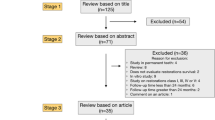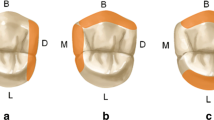Abstract
AIM: The objective of the study was to determine the influence of the experience of the operator and the assistant on the survival rate of proximal ART-restorations after 2 years when placed using two methods of tooth-isolation and three glass ionomer cement-brands. STUDY DESIGN: A clinical intervention study. METHODS: Each of 804 children aged 6–8 years received one proximal restoration in their primary molars. The restorations were placed by ‘experienced/inexperienced’ operators randomly paired with ‘experienced/ inexperienced’ assistants. The atraumatic restorative treatment (ART) approach was used with 3 brands of glass ionomer cements (GIC) and 2 tooth-isolation methods (rubber dam vs cotton rolls). Trained and calibrated evaluators evaluated the restorations, soon after placement and after 2 years. STSTISTICS: The data collected were analyzed using SPSS 14.0, to determine and relate the survival rate of the restorations to the operator and assistant with respect to the other factors such as the restorative material used and the isolation method applied. RESULTS: After 2 years, the survival rate of the restorations was 30.8%. In general, there were no statistical significant differences in the survival rate of the restorations made by the ‘experienced’ vs ‘inexperienced’ operators, but individually, the operator with more experience was associated with a significantly higher survival rate of the restorations. The experienced assistants were associated with significantly higher survival rates of the restorations. The most ‘experienced’ operator paired with any ‘experienced’ assistant and using rubber dam tooth-isolation method, was associated with a significantly higher survival rate of the restorations. CONCLUSION: The combination of the ‘experienced’ operator and assistant using rubber dam tooth-isolation method had the best chance of survival for proximal ART restorations, irrespective of the material-brand used.
Similar content being viewed by others
References
Abramowitz J. Expanded functions for dental assistants: a preliminary study. J Amer Dent Assoc 1966; 72:386–391.
Cohen J A. coefficient of agreement for nominal scales. Educational and Psychological Measurement 1960; 20:37–46.
Frencken JE, Pilot T, Songpaisan Y, Phantumvant P: Atraumatic restorative treatment ART) rationale, technique and development. J. Public Health Dent 1996a; 56:135–40.
Frencken JE, Makoni F, Sithole WD. Atraumatic restorative treatment and glass ionomer sealants in a school oral health programme in Zimbabwe: evaluation after one year. Caries Res 1996b; 30:428–433.
Frencken JE, Holmgren CJ. Atraumatic restorative treatment for dental caries. Nijimegen STI Book b.v., 1999, ISBN 906759024X.
Frencken JE, Borsun-Anderson K, Makoni F, et al. Effectiveness of an oral health education programme in primary schools in Zimbabwe after 3.5 years. Community Dent Oral Epidemiol 2001;29:253–9.
Frencken JE, van’t Hof MA, van Amerongen WE, Holmgren CJ. Effectiveness of single-surface restorations in the permanent dentition. A meta-analysis. J Dent Res 2004; 83:120–3.
Fritz UB, Finger WJ, Stean H. Salivary contamination during bonding procedures with one bottle adhesive systems. Quintessence Int 1998;29:567–72.
Hawthorne WS, Smales RJ. Factors influencing long-term restoration survival in three private dental practices in Adelaide. Aus Dent J 1997; 42:59–63.
Lo ECM, Holmgren CJ. Provision of atraumatic restorative treatment (ART) restorations to Chinese pre-school children — a 30-month evaluation. Int J Paed Dent 2001;11:3–10.
Lo ECM, Luo Y, Fan MW, Wei SHY. Clinical investigation of two glass ionomer restoratives used with the atraumatic restorative treatment approach in China: two year results. Caries Res 2001; 35:458–463.
Mickenautsch S, Rudolph MJ. Undergraduate training in the atraumatic restorative treatment (ART) approach — an activity report. S Afric Dent J 2002;57:355–57.
Mickenautsch. S., Harkison B, Grossman E, Voids in ART restorations: effect of operator expertise and mixing mode. J Dent Res 2003; 82:C–623 (abstract 75).
Mickenautsch S, Grossman E. Atraumatic restorative treatment (ART) — factors affecting success. J Appl Oral Sci 2006;14(5):32–37.
Mjör IA, Dahl JE, Moorhead JE. Age of restorations at replacement in permanent teeth in general dental practice. Acta Odontol Scand, 2000;58:97–101.
Mjör IA, Gordan VV. A review of Atraumatic Restorative Treatment (ART). Intern Dent J 1999; 49:127–31.
Nomoto R, McCabe JF. The effect of mixing methods on the compressive strength of glass ionomer cement. J dent 2001; 29(3):205–10.
Rahimtoola S, van Amerongen E. Comparison of two tooth saving preparation techniques for one surface cavities. J Dent Child 2002; 69:16–26.
Ryge G, Snyder M. Evaluating the clinical quality of restorations. J Amer Dent Assoc 1973; 87:369–377.
Smales RJ, Webster DA, Leppard PI. Survival predictors of amalgam restorations. J Dent 1991;19:272–77.
Taifour D, Frencken JE, Beiruti N, Truin GJ. Effects of glass ionomer sealants in newly erupted first molars after 5 years: a pilot study. Community Dent Oral Epidemiol 2003;31:314–19.
van Amerongen WE. Dental caries under glass ionomer restorations. J Public Health Dent 1996;56(3):150–54.
van den Dungen GM, Huddleston Slater AE, van Amerongen WE. ART or conventional restorations? A final examination of proximal restorations in deciduous molars. Ned Tijdschr Tandheelkd 2004;111:345–349.
van der Hoef N, van Amerongen WE. Influence of local anaesthetic on the quality of class II glass ionomer restorations. Inter J Paediatr Dent 2007;17(4):239–47.
van Gemert-Schriks MCM, van Amerongen WE, ten Cate JM, Aartman IHA. Three-year survival of single- and two-surface ART restorations in a high-caries child population. Clin Oral Invest 2007; 11(4):37–43.
Yu C, Gao XJ, Deng DM, Yip HK, Smales RJ. Survival of glass ionomer restorations in primary molars using atraumatic restorative treatment (ART) and conventional cavity preparations: 2-year results. Int Dent J 2004;54:42–6.
Author information
Authors and Affiliations
Corresponding author
Rights and permissions
About this article
Cite this article
Kemoli, A.M., van Amerongen, W.E. & Opinya, G. Influence of the experience of operator and assistant on the survival rate of proximal ART restorations: two-year results. Eur Arch Paediatr Dent 10, 227–232 (2009). https://doi.org/10.1007/BF03262687
Published:
Issue Date:
DOI: https://doi.org/10.1007/BF03262687




